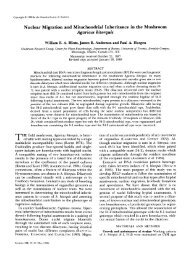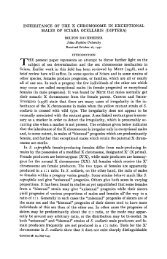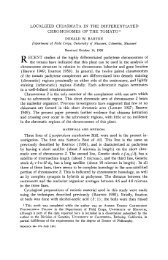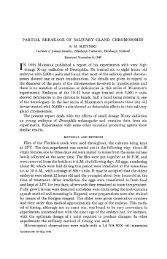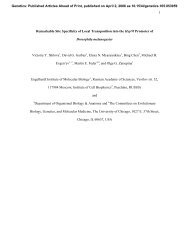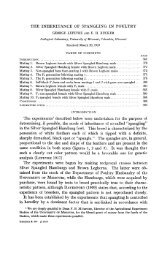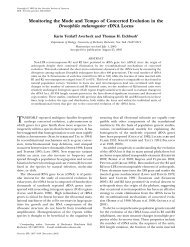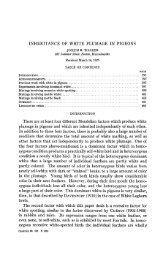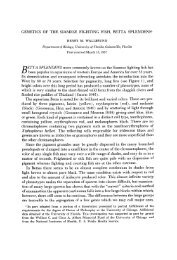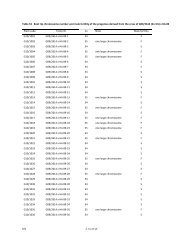abstracts of papers presented at the 1962 meetings - Genetics
abstracts of papers presented at the 1962 meetings - Genetics
abstracts of papers presented at the 1962 meetings - Genetics
Create successful ePaper yourself
Turn your PDF publications into a flip-book with our unique Google optimized e-Paper software.
ABSTRACTS 971<br />
63.1%. These results differ markedly from those obtained by OSTERTAG and by ourselves from<br />
irradi<strong>at</strong>ion <strong>of</strong> third-instar larvae, which show much lower mortality among females than males<br />
and among nondeficient than deficient individuals. We conclude th<strong>at</strong> irradi<strong>at</strong>ion kills <strong>the</strong>se<br />
early embryos, unlike l<strong>at</strong>er stages, by a different process, for <strong>the</strong> most part, than chromosome<br />
loss. Our d<strong>at</strong>a show, moreover, th<strong>at</strong> this mortality, unlike th<strong>at</strong> induced by l<strong>at</strong>er irradi<strong>at</strong>ion, is<br />
concentr<strong>at</strong>ed within a rel<strong>at</strong>ively short postirradi<strong>at</strong>ion period. (Supported by U. S. Public Health<br />
Service contract RG-5286, C4.)<br />
MILKMAN, R., Syracuse University, Syracuse, New York: Crossveinless polygenes in 40 wild<br />
lines <strong>of</strong> Drosophila me1anogaster.-Each <strong>of</strong> 40 wild insemin<strong>at</strong>ed females collected in three Syracuse<br />
locales was allowed to produce progeny. From each F, 1000 flies were examined for posterior<br />
crossvein defects. Of <strong>the</strong> 40 lines, only four contained no crossveinless (cue) flies. Among<br />
<strong>the</strong> rest, 28 contained between one and seven per 1000; five contained between 11 and 19; and<br />
three contained between 46 and 63.-The six highest strains have been subjected to selection for<br />
<strong>the</strong> crossveinless phenotype. A polygenic basis for <strong>the</strong> trait is indic<strong>at</strong>ed in each case, and progress<br />
has been quite rapid. These results confirm and extend conclusions about <strong>the</strong> genetic basis<br />
<strong>of</strong> <strong>the</strong> cue phenotype in n<strong>at</strong>ure: it appears to result from <strong>the</strong> rare combin<strong>at</strong>ion <strong>of</strong> fairly common<br />
genes. Whe<strong>the</strong>r <strong>the</strong>se genes in a local popul<strong>at</strong>ion are common as a class or common as<br />
individual alleles remains to be determined from crosses. Indic<strong>at</strong>ions from crosses <strong>of</strong> cue strains<br />
<strong>of</strong> diverse origins are th<strong>at</strong> for <strong>the</strong> species as a whole <strong>the</strong>re are many different alleles which<br />
produce <strong>the</strong> cue trait in some teams and not in o<strong>the</strong>rs.<br />
MITTLER, SIDNEY, and G. N. SAMPSON, Nor<strong>the</strong>rn Illinois University, DeKalb, Illinois: Distorted<br />
sex r<strong>at</strong>io in <strong>of</strong>fspring <strong>of</strong> <strong>at</strong>tached-X females in D. me1anogaster.-The sex r<strong>at</strong>io <strong>of</strong> <strong>the</strong><br />
stock B lua sCS In SSI (Muller-5) yf: = is 1 yellow forked female to 1.18 Bar eye male, however<br />
when <strong>the</strong> <strong>at</strong>tached-X females are m<strong>at</strong>ed to Canton-S males <strong>the</strong> r<strong>at</strong>io <strong>of</strong> <strong>the</strong> <strong>of</strong>fspring is 1 <strong>at</strong>tached-X<br />
female to 1.98 Canton-S male. The sex r<strong>at</strong>io <strong>of</strong> <strong>the</strong> F, <strong>of</strong> this cross is 1 to 2.77. The<br />
excess <strong>of</strong> males from m<strong>at</strong>ings to <strong>at</strong>tached-X females was also found in <strong>the</strong> <strong>of</strong>fspring <strong>of</strong> m<strong>at</strong>ings<br />
with Oregon-R males. The F, r<strong>at</strong>io is 1 to 1.52; F,, 1 to 1.49; F,, 2,904 males to 1,974 females or<br />
1 to 1.47. The females are always <strong>at</strong>tached-X and <strong>the</strong> males Oregon-R. At first it was believed<br />
th<strong>at</strong> <strong>the</strong> excess <strong>of</strong> males was due to <strong>the</strong> Y chromosomes <strong>of</strong> <strong>the</strong> Canton-S and Oregon-R in th<strong>at</strong><br />
this chromosome did not stimul<strong>at</strong>e <strong>the</strong> development <strong>of</strong> <strong>the</strong> <strong>at</strong>tached-X egg. The Y chromosomes<br />
th<strong>at</strong> fertilize <strong>the</strong> <strong>at</strong>tached-X egg in <strong>the</strong> F, and even numbered F gener<strong>at</strong>ions are from <strong>the</strong><br />
original M8/yf: = stock and excess males are also found in <strong>the</strong>se gener<strong>at</strong>ions. The M-5 male<br />
may not be as viable as <strong>the</strong> Oregon-R or Canton-S males and if <strong>the</strong> viability <strong>of</strong> <strong>the</strong> <strong>at</strong>tached-X<br />
female is also reduced or <strong>the</strong> production <strong>of</strong> <strong>the</strong>se eggs is less, this can account for <strong>the</strong> excess <strong>of</strong><br />
males in m<strong>at</strong>ings to <strong>at</strong>tached-X. There may be also some factor or factors on <strong>the</strong> o<strong>the</strong>r chromosomes<br />
introduced by m<strong>at</strong>ing with Oregon-R or Canton-S th<strong>at</strong> may inhibit <strong>the</strong> production <strong>of</strong><br />
<strong>at</strong>tached females.<br />
MOH, C. C., Inter-American Institute <strong>of</strong> Agricultural Sciences, Turrialba, Costa Rica: The<br />
effects <strong>of</strong> p-dichlorobenzene pretre<strong>at</strong>ment and temper<strong>at</strong>ures on <strong>the</strong> chromosome morphology <strong>of</strong><br />
Phaseolus vulgaris.-In studying <strong>the</strong> cytology <strong>of</strong> Phaseolus species, <strong>at</strong>tempts were made to find<br />
a suitable cytological technique to facilit<strong>at</strong>e chromosome counting and <strong>the</strong> morphology study.<br />
A s<strong>at</strong>isfactory and rel<strong>at</strong>ively simple technique was to pretre<strong>at</strong> <strong>the</strong> germin<strong>at</strong>ing seeds (two-day old<br />
with a radicle 0.5 to 1.0 cm long) with a s<strong>at</strong>ur<strong>at</strong>ed aqueous solution <strong>of</strong> p-dichlorobenzene as<br />
described by MEYER (Stain Technol. 20: 121-125, 1945) but using low temper<strong>at</strong>ures. The pretre<strong>at</strong>ed<br />
radicles were <strong>the</strong>n excised, fixed in cold Carnoy's fluid (4°C) for two to three days, and<br />
stained with a mixture <strong>of</strong> ten parts aceto-orcein plus one part 1N HC1 before <strong>the</strong> smear was<br />
made.-Pretre<strong>at</strong>ment <strong>at</strong> high temper<strong>at</strong>ures (e.g. 25 "C) usually caused chromosome stickiness<br />
and little chromosome sc<strong>at</strong>tering, and thus made <strong>the</strong> observ<strong>at</strong>ion difficult. The best results were<br />
obtained by pretre<strong>at</strong>ing <strong>the</strong> cytological m<strong>at</strong>erial <strong>at</strong> 4°C for 6 to 24 hours depending upon <strong>the</strong>





